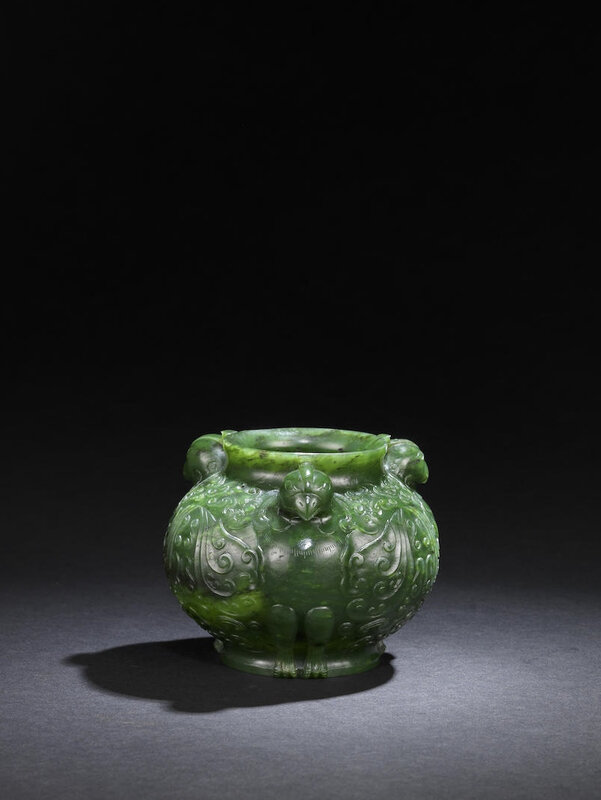A rare spinach-green jade 'heavenly bird' jar, zun, Qianlong-Jiaqing period (1736-1820)
Lot 39. A rare spinach-green jade 'heavenly bird' jar, zun, Qianlong-Jiaqing period (1736-1820); 10.1cm (4in) wide. Estimate HK$ 250,000-400,000. Sold for HK$ 312,500 (€ 37,126). Courtesy Bonhams.
Of globular form, the shoulders carved in relief with three evenly spaced heavenly birds, each with its talons perched on the flared hollow foot, the wings outstretched with finely incised details at the plumage, all above archaistic scrolls delicately worked in low relief, the stone of a rich spinach-green tone with dark speckles.
Provenance: Spink & Son Ltd., London (label)
An English private collection.
Note: The three archaistic flying mythical creatures are known as 'heavenly birds' or tianji and are commonly mistaken as phoenixes. The legend of tianji dates back to the Jin dynasty (AD 265–420) as recorded in Xuanzhongji or 'Records of Mysterious Phenomenons' by the Eastern Jin scholar and writer Guo Pu (AD 276-324). It is said that there lies a giant tree on Mount Taodu whereby the tree is so immense it shades an area of five thousand kilometres. The tianji is found perched on the tree while other birds mimic its singing. Another 4th-6th century record also mentions the tianji as a bird that could fly a thousand miles high and whose flapping wings would produce thunderous sounds when outstretched.
An earlier prototype from the Tang dynasty of this unusual form of jade zun is illustrated by Zheng Xinmiao, Compendium of Collections in the Palace Museum: Jade 5: Tang, Song, Liao, Jin and Yuan Dynasties, Beijing, 2011, no.1. However, it appears that the inspiration for the form may stretch back further into ancient Chinese history: in Chinese Jades Throughout the Ages - Connoisseurship of Chinese jades, Vol.II, pp.136-137, no.68, Li illustrates another 18th century example of the jar, but also notes that 'this piece imitates a style of turtledove decoration from the Han period.'
This vessel is consistent with the style advocated by the Qianlong emperor; as noted by Chang Li-tuan in The Refined Taste of the Emperor: Special Exhibition of Archaic and Pictorial Jades of the Ch'ing Court, National Palace Museum, Taipei, 1997, p.49, the Qianlong emperor proposed to 'restore ancient ways', suggesting that jade carvers turn to antiquity for models, which would enable them to imbue their designs with simplicity and honesty, and so achieve refinement and elegance. The 'ancient ways' referred to the intrinsic values of sincerity, simplicity, and happy exuberance.
A similar spinach-green jar, Qianlong mark and period, is illustrated in Masterworks of Chinese Jade in the National Palace Museum, Supplement, Taipei, 1973, no.41.
A similar jar of darker spinach-green jade, Qianlong seal mark and period, sold in our London rooms, 15 May 2014, lot 181.
Bonhams. Fine Chinese Ceramics and Works of Art, Hong Kong, 3 December 2015

/https%3A%2F%2Fprofilepics.canalblog.com%2Fprofilepics%2F1%2F0%2F100183.jpg)
/https%3A%2F%2Fstorage.canalblog.com%2F03%2F02%2F119589%2F96711876_o.jpg)
/https%3A%2F%2Fstorage.canalblog.com%2F11%2F31%2F119589%2F94773502_o.jpg)
/https%3A%2F%2Fstorage.canalblog.com%2F20%2F83%2F119589%2F94772815_o.jpg)
/https%3A%2F%2Fstorage.canalblog.com%2F26%2F72%2F119589%2F75604929_o.jpg)
/https%3A%2F%2Fstorage.canalblog.com%2F59%2F60%2F119589%2F26458628_o.jpg)



/http%3A%2F%2Fstorage.canalblog.com%2F04%2F42%2F119589%2F129831017_o.jpg)
/http%3A%2F%2Fstorage.canalblog.com%2F53%2F21%2F119589%2F129409104_o.jpg)
/http%3A%2F%2Fstorage.canalblog.com%2F79%2F64%2F119589%2F129153779_o.jpg)
/http%3A%2F%2Fstorage.canalblog.com%2F97%2F23%2F119589%2F128165935_o.jpg)